Spiders
Just the mention of the word can bring many people out in hot and cold flushes. Spiders! Somehow, these creatures instill a lot of fear in many people, and it may be an ancestral trait, for some of these creatures are certainly capable of harming us. However, in more temperate northerly climes like ours, few spiders are capable of harming us, let alone likely to. We do have black widows to keep an eye out for here and there, otherwise, our spiders are pretty innocuous to us and should not be feared. Spiders form a large and complex group of invertebrates, and identifying all that you may encounter is far beyond what can be achieved without microscopy and dissection - and that is not the intention of this website. Here are presented some of the more noticeable and readily identifiable species that you may come across in the Cape May area.
Spiders differ most obviously from insects in having eight (not six) legs and in having two (not three) major body parts - the abdomen, and a fused head and thorax that is known as the cephalothorax.
Useful pointers to look for when identifying spiders include amount of hairiness, number and positioning of eyes (most spiders have eight!) and overall size and shape. For many species, a hand lens or even a microscope would be necessary to identify them, based on their external genitalia.
(For a list of all spider species on the site, click here)
Use the photos below to narrow your search to a group of spiders, then click on the picture to go to the next stage.
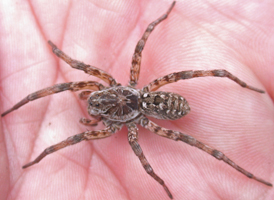 |
Wolf Spiders
Small to large spiders that do not make webs but hunt actively over the ground. Usually rather stout-legged and stocky overall. Some species live in burrows in the ground.
|
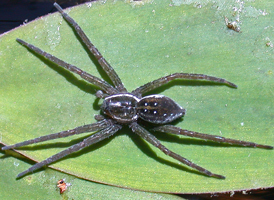 |
Nurseryweb Spiders
Medium to large spiders that do not make webs but hunt actively over the ground. Similar to wolf spiders but nurseryweb spiders tend to rest with the legs outstretched and flattened to the ground. This group includes the fishing spiders that may be found hunting on the surface of ponds and other waterways.
|
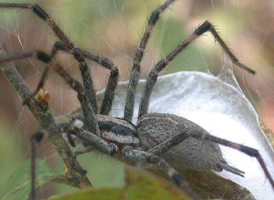 |
Funnel Weavers
Medium to large spiders that are mostly creatures of dark corners and sheltered places, so are often overlooked. Generally long-legged and hairy, with often quite large spinnerets at the back end of the abdomen. Webs often large, forming an open sheet with a funnel to hide in at one end.
|
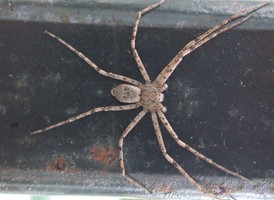 |
Running Crab Spiders
A peculiar-looking group with elongated legs and a very flattened profile. These spiders have a habit of running away sideways suddenly and quickly if disturbed.
|
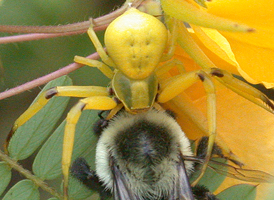 |
Crab Spiders
May be dark in color, or may be brightly colored, to match their surroundings. Yellow, white, green or pink are common colors for these spiders, which are most often found lurking on flower heads in the hope of trapping a visiting pollinator. Leg placement gives an overall crab-like look, and these spiders often move sideways in a crab-like fashion.
|
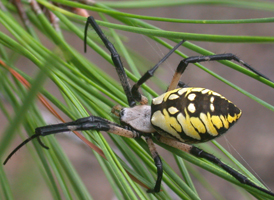 |
Orb Weavers
These are perhaps the 'classic' spiders, spinning circular webs across gaps in vegetation to catch flying insects. A large and variable group, but generally with large and colorful or strongly-marked abdomens.
|
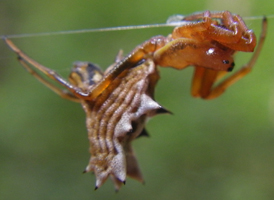 |
Orb Weavers
These are perhaps the 'classic' spiders, spinning circular webs across gaps in vegetation to catch flying insects. A large and variable group, but generally with large and colorful or strongly-marked abdomens.
|
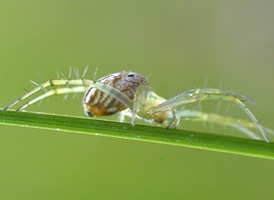 |
Orb Weavers
These are perhaps the 'classic' spiders, spinning circular webs across gaps in vegetation to catch flying insects. A large and variable group, but generally with large and colorful or strongly-marked abdomens.
|
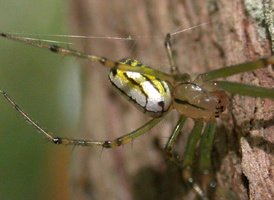 |
Long-jawed Orb Weavers
A group of mostly rather slender spiders with narrow abdomens and spindly legs. Many species make their orb webs low in mixed vegetation in damp areas, while some are woodland species. Wetland species are often found among grasses or reeds, where they shelter under narrow leaves with their legs extended front and back.
|
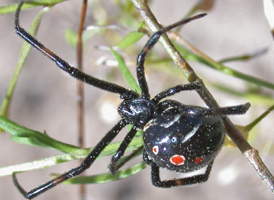 |
Cobweb Spiders
Generally rather small, long-legged spiders with relatively short, rounded abdomens. Most species make rather messy, three-dimensional webs, made up of a tangle of simple threads.
|
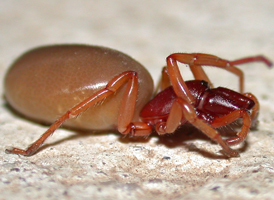 |
Dysderid Spiders
Distinctive spiders with rather swollen, pale abdomens and noticeably large chelicerae (jaws).
|
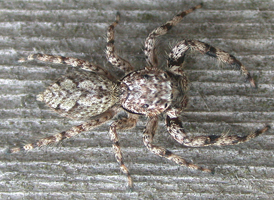 |
Jumping Spiders
A diverse bunch of small spiders that make no webs but hunt actively in a territory. Jumpers may be hairy or smooth and are best distinguished as a group by their jerky, active movements and the configuration of the six (not eight) eyes, with the front facing pair being larger than the rest and looking like a pair of goggles. Adults often cryptically colored, but juveniles may be brighter and more boldly patterned.
|
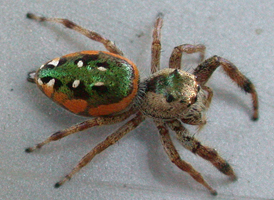 |
Jumping Spiders
A diverse bunch of small spiders that make no webs but hunt actively in a territory. Jumpers may be hairy or smooth and are best distinguished as a group by their jerky, active movements and the configuration of the six (not eight) eyes, with the front facing pair being larger than the rest and looking like a pair of goggles. Adults often cryptically colored, but juveniles may be brighter and more boldly patterned.
|
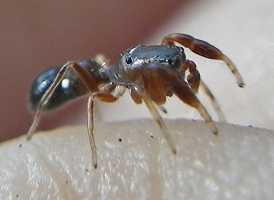 |
Jumping Spiders
A diverse bunch of small spiders that make no webs but hunt actively in a territory. Jumpers may be hairy or smooth and are best distinguished as a group by their jerky, active movements and the configuration of the six (not eight) eyes, with the front facing pair being larger than the rest and looking like a pair of goggles. Adults often cryptically colored, but juveniles may be brighter and more boldly patterned.
|
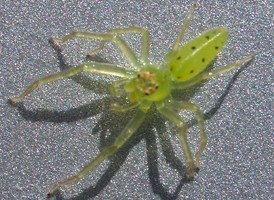 |
Jumping Spiders
A diverse bunch of small spiders that make no webs but hunt actively in a territory. Jumpers may be hairy or smooth and are best distinguished as a group by their jerky, active movements and the configuration of the six (not eight) eyes, with the front facing pair being larger than the rest and looking like a pair of goggles. Adults often cryptically colored, but juveniles may be brighter and more boldly patterned.
|
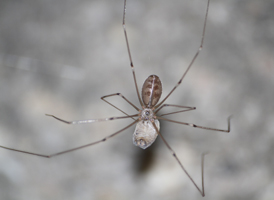 |
Cellar Spiders
Common to abundant spiders in cellars and basements where they favor setting their tangled webs in corners. Also regularly enter all rooms of houses and other occupied buildings. Legs are noticeably long and slender while head and jaws are rather small.
|
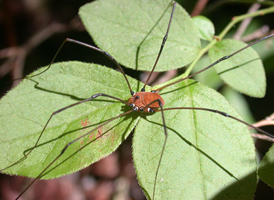 |
Harvestmen
Though not true spiders, harvestmen are included here as they are likely to be confused with spiders by the casual observer. The head and body are fused into a single, rounded structure and the legs are very long, thin and spindly. They roam actively on the ground and can be abundant in woodland areas.
|